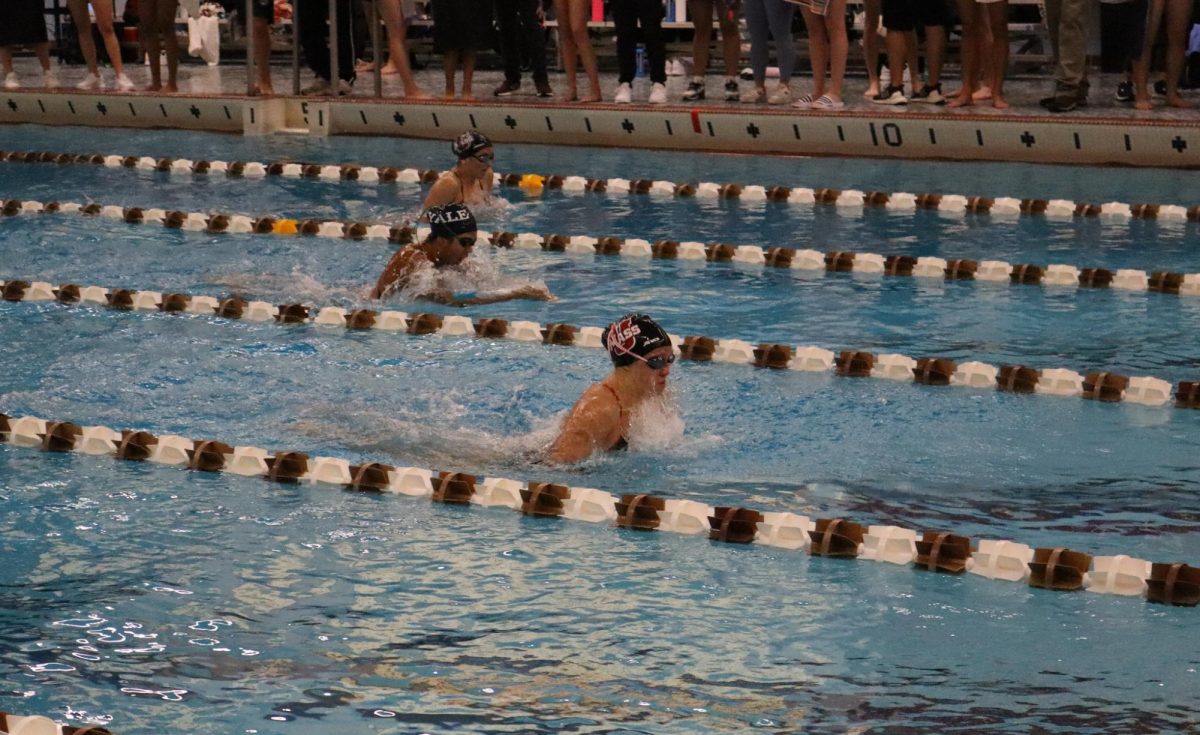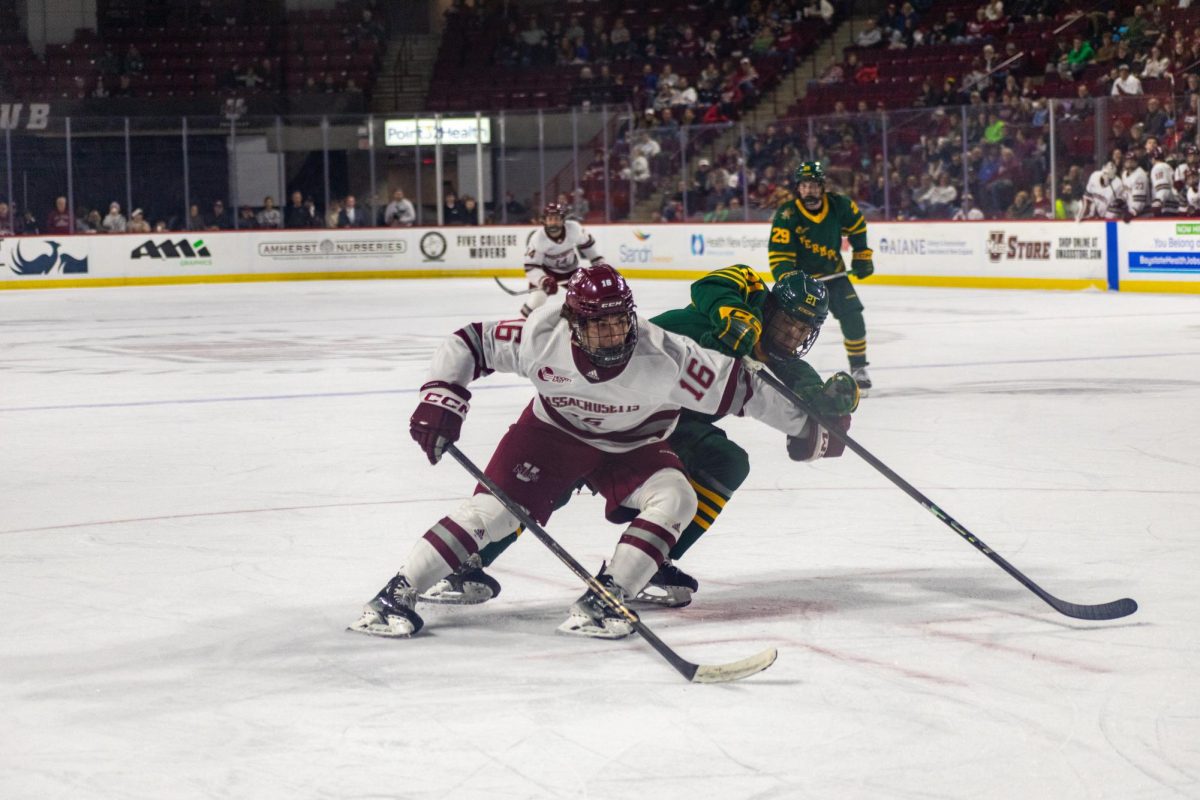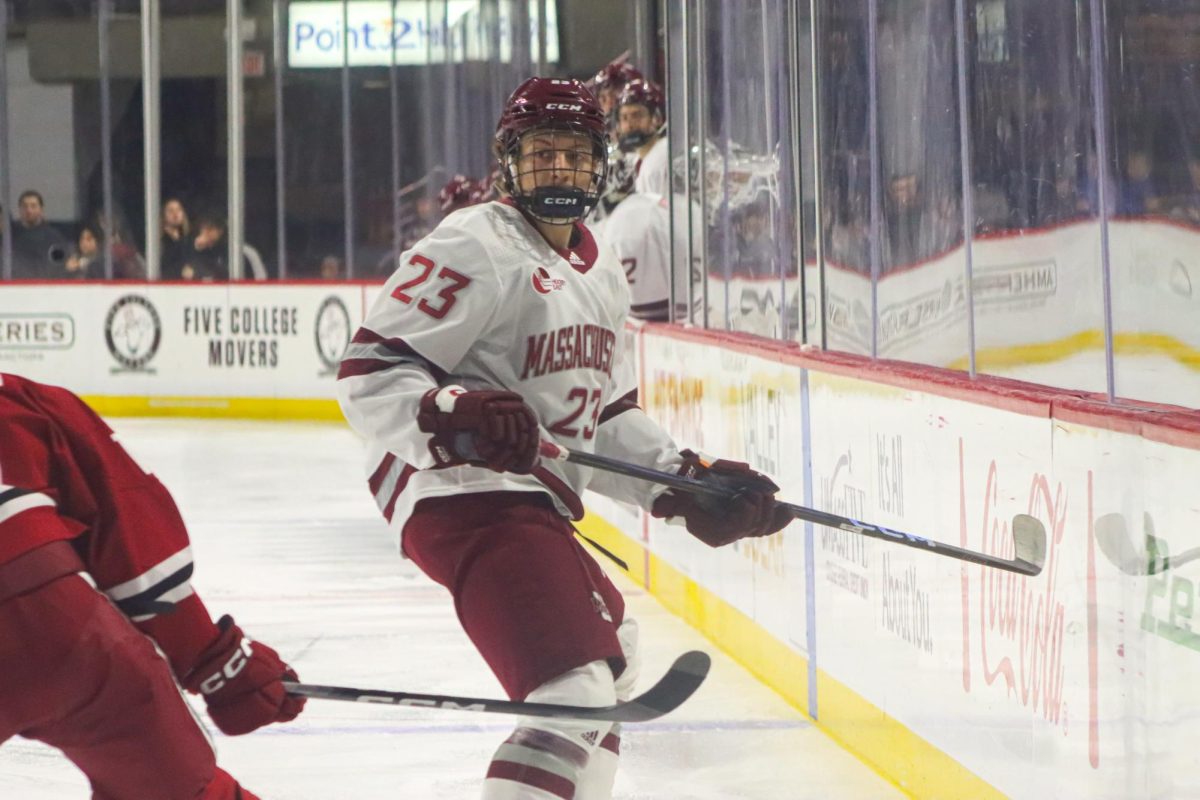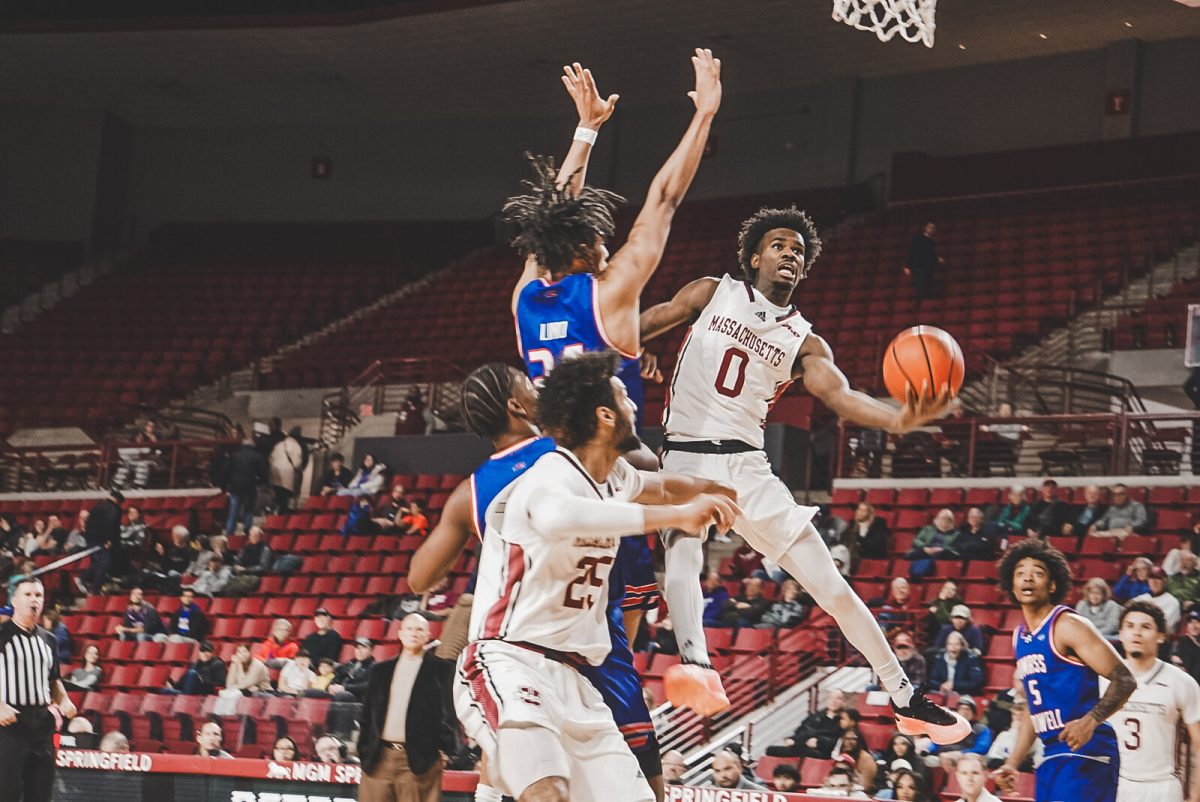If you walk the hallways of Herter Hall when classes are over for the day, there’s a good chance you’ll witness bandmates gathering to rehearse. As classes disassemble, the roar of guitar and bass fills the empty rooms. The moment these students wait all day for arrives with the drummer. The drum set is built in the center of the room as more gear is hauled in from the car. Once the band has ear protection and the drummer takes a seat, the reverberations of the music are breathtaking. The drummer channels energy through every limb to make the entire room shake.
Since becoming a student at the University of Massachusetts Amherst, Herter has become a staple of my college life. Being the drummer in two bands on campus means I’m always moving gear around, setting up there, practicing and searching for shows to play. During my time at UMass, I have met and played with a lot of hardworking bands, and I’ve found that the bands that rock the hardest have a unique and confident drummer that stands out immediately. Not only is it the drummer’s job to hold the music together with accurate timing, but they’re also responsible for the “feel” and ability to move the audience. Drummers manage a lot of gear and are often prepare for a show before their bandmates. Though drum players are in high demand on campus, it is a challenge for students to keep drums on them and find places to play full volume.
I talked with three of the most entertaining musicians in the Pioneer Valley, drummer-to-drummer. Each of them had their drum set present and were either performing or practicing. Each brought their own personal flair to the instrument, presenting their style through the gear they’d organized for themselves. The thread between these three drummers, and any good musician, is the hunger to always be better on the instrument. They practice for years just to get one song down, one drum-fill, one tempo and suddenly hours of regimented work blossoms into calm, creative control and musical freedom. Not to mention the drums are hard to get around, require lots of maintenance and every moving drum part alone gets as expensive as a nice guitar.
ANNIE RICHARD
Despite the event staff at the Campus Center Auditorium requesting that acts have a more “chill” set for the Vintage Market that day, the women of Sapien Joyride were in good spirits. They prefer loud, packed shows, but the calm setting of people walking around allows the audience to hear their original music clearly, putting their wonderful chemistry on display. Sapien stepped off stage to shake-up my bandmates and I after their performance. Annie Richard, the drummer, showed off her Mapex drums setup on the stage, a Frankenstein like combination of cracked cymbals, unique shell sizes and some of the band’s old drummer’s stuff; a drum set her band calls Bertha. Richard’s clothes are rockstar, draped in chains, rips and custom accessories. Her tattoos are big and wild, and her hair is red and black. She waves her hands toward the set, “This is my baby and she lives at school, and we don’t treat her the best.” Being rag-tag with gear is all about style, and if she didn’t have the Mapex her dream kit would be a “shitty Yamaha kit,” or some drums that are gimmicky. Richard’s playing is accurate and tight, combined with ferocious endurance. The weekend before at a house party in Holyoke, the house-drums were beaten up, unbranded and in a cramped basement. Both Richard and I played drums that night, cracking up together before the show while attempting to tune the drum set. Richard attacked the drums with precision and didn’t give them a break until the end of the performance.
“I really like to focus on where I’m hitting, and why I’m hitting and what I’m hitting,” she says. She describes her dream drum sizes, demanding everything be small and untraditional. Smaller drums have less surface area requiring more precision for a sharper hit.
When practicing, she welcomes any kind of difficulty and is most comfortable on the Mapex set because it’s falling apart. When she gets the chance to rip it up on a good drumset, she doesn’t have to work so hard. It’s like she’s always on the run, using worn-out gear or asking other performers to borrow equipment at a show. She may seem all over the place, but her skills are grounded in years of hard work, performance experience and even research.
Richard grew up in Brooklyn, New York, and started playing the drums at five-years-old. She started with private lessons in middle school and continued through high school. Ringo Starr (The Beatles), Keith Moon (The Who), Neil Peart (Rush) and John Bonham (Led Zeppelin) inspired her to play the drums. “Keith Moon can fit 120 notes in a 4 bar measure,” she says reflecting on her influences.
Richard played with others any chance she got, filling in for a handful of DIY bands in the Brooklyn music scene. But no band of her own ever materialized until Sapien Joyride, the most serious project she’s been a part of. She’s now a junior at Hampshire College studying classic rock, rock history and journalism.
“I’m learning a lot, and I’m weirdly becoming a better musician than I have in the past 15 years of me playing drums. Just gigging and doing the thing, and making it sound different and better each time,” Richard says. “The last thing you wanna do is get worse at the thing you love doing.”
In Oct. 2023 Richard took on Sapien, and her origin story is reflective of her brutally exciting play-style. Sapien Joyride, previously named “Quit Hours,” once had an original drummer when it began in 2022. She was a girl who laughed when her bandmates sat down for a serious discussion about taking their music to new heights. Richard lives next door to the girls’ Hampshire “greenhouse mod,” where they practice. She remembers hearing a cover of “Rebel Girl” by Bikini Kill coming from the greenhouse attached to the house.
Despite having taken a break from the drums at school, Richard took a chance and walked up to the house to knock on the door. “You guys looking for a drummer?” Richard was welcomed in, played the drums with the girls that day, and the other drummer was asked to leave soon after. She laughs at the details because she knew how much she could offer to an already cool band and knew that the drummer had to go. To Richard, a careless drummer with low expectations is an injustice to the band and it was love for the creation of music that brought her to Sapien Joyride’s door.
The completed trio played their first “real gig” at The Drake in Amherst for WMUA’s Battle of the Bands. They won, and since last Fall, Richard says the band plays almost every weekend and at the Vintage Market. That Wednesday marked the first time in two months they didn’t have a gig on the weekend. They’ve also released an album, “Everything (that I touch),” and three single projects.
“I play with a sense of calm, and centeredness, it’s almost like a form of meditation,” she says, but it all comes down to the day and style of the show. “I want people to move their bodies, and feel it in their chest. I want people to understand why we do what we do.”
Richard says that during a show any suppressed emotions run wild through her arms and legs and into the drums. She radiates uniqueness from her aura, but has faced the problem many drummers feel when putting themselves out there.
“I went through a phase where I compared myself to everyone in the Pioneer Valley, but I don’t play like them,” she says. Annie’s most comfortable playing the drums for herself, fueling her bandmates and inspiring others to be themselves on their instrument. In a music scene flooded by men, Sapien Joyride puts “girls to the front,” and you’re going to feel it in your chest.
THOMPSON TANCH
On the other side of “give me any drum I can hit,” there’s a drummer whose style is like a tailored suit and tie. After Richard performed with Sapien Joyride, I stuck around the Vintage Market to talk with Thompson Tanch of The Howlers, a five-piece band that play the blues, rock, classic rock and alternative rock cover songs, alongside new original music. Tanch is the humble coordinator, operating The Howlers socials and booking shows for the group to play. He takes pride in “fighting” for their first gig, explaining that getting involved with the music scene while at UMass was a must for him.
Tanch and his bandmates had crossed musical paths before, practicing in a dorm hall, but it wasn’t until his junior year that singer and friend Ragan McKenna made the call to form the band. Tanch tells the story, “One night at a party at our apartment, our singer walks into our room, looks me dead in the eyes and goes ‘we should start a band’ I was like, ‘done.’”
With a group finally put together, The Howlers played their first show at the end of fall semester at a house party held in a garage. The excitement from the crowd reassured Tanch that they were onto something. In the spring they took a short break, taking on a stand-in singer to play just one more show to end the year. Last fall was when they decided to take things more seriously. Tanch says UMass Fall Fest ‘23 was when they started booking more shows.
The Howlers have been playing consistently, making everything count before the band’s graduation in the spring. Right now, it’s go-go-go. They’re in the process of recording an original EP and rehearsing for upcoming shows. He hopes the group can find some time after college to have fun and keep the music going, but even without a band, Tanch has plans to keep improving on the drums.
Tanch has a calculated supporting role playing heavy, kick-centered grooves that expertly blend in with the group’s classic rock sound. He spoils his band with dance worthy tempo and sound level, laying a foundation for his bandmates to sway and vibe on stage without being overwhelmed by drums. He’s constantly looking into his bandmates’ eyes, locking in and setting up musical cues that make the band sound super tight. Looking at his drum set, you’ll notice that his vibe has been formed by being a classic rock and roll connoisseur.
His drum set is a three-piece, wood-glaze finish Gretsch kit, with an added Ludwig rack-tom mount on the kick. He stomps on a Ludwig Speed Flyer bass drum pedal, uses Paiste cymbals and recently switched from 5a to 5b sticks (the bigger, heavier option).
His drums are no joke. They’re expensive (starting at around $1,000), in excellent condition, and everything is carefully thought out and modified to fit his style, which is heavily inspired by drummer John Bonham (Led Zeppelin). Tanch bought the set with cases before his senior year. “The drumset costs me about a third of what I made over the summer,” he says nervously, with a smile.
Tanch’s sticks and drumheads are almost spotless, which confused me at first. He explained that when he rehearses alone or with the band in his Amherst apartment, he has to put mutes on all his drums to keep them silent. While he doesn’t always have the freedom to play as loud as he wants at home, “it feels so rewarding to finally play the kit without the mutes,” he says.
Tanch became curious about drumming as a child after his dad showed him a 20-year-old drum set that he used to play. He says he never thought he was going to be a drummer. But looking back, he laughs recalling banging on tables and driving his friends mad. By his freshman year of high school, his curiosity about the drums led his dad to buy him his very own electronic drum set.
There was a unique opportunity available to him to play the drums in a school musical theater event, but he didn’t have the credentials for it. In a matter of only three months between freshman and sophomore year, Tanch learned the entirety of “Bohemian Rhapsody” on drums. “Technically I had until the following March but I needed to show that I could actually play it by September, I was like, ‘I need to do this now,’” he says. He got the gig.
“I didn’t think I was gonna fall in love with it [drumming] as much as I did, from when I started learning that song [Bohemian Rhapsody] over that one summer,” he says. When his dad encouraged him to save for college, he bought a drum set, because to him, that is college.
What’s most impressive about Tanch’s playing and origin on the drums is that he taught himself everything he knows. “A personal regret is that I never took formal lessons. Teaching myself throughout the years I didn’t try to wing it, I looked at actual lessons online, but I never had an instructor sit down with me,” he says.
He has considered private lessons after college. “I wanna learn more about some jazz stuff, I wanna make that my next path to take,” he says.
Tanch is uniquely tied to his musical influences because he studies their drumming technique and then works tirelessly to play it as it sounds on the record. He loves Bonham, so naturally he attacked Led Zeppelin tunes first. After learning through “Bohemian Rhapsody,” he practiced by playing a song over and over, studying until he could create a similar drum sound. He admits there were some he should have saved until he was a little better, one of the songs being “Ten Years Gone,” by Led Zeppelin, for its carefully placed kicks.
“It wasn’t until a year ago where I got it [playing the drums] to a place where I was feeling good and I was confident I could do the doubles and the stuff I wanted to do. That was after many, many, many attempts of banging my head against the wall,” he says. The only way he saw comfort in fancy footwork was persistence. “I’m gonna keep doing it until my leg gives out!”
On the drum set he feels the most powerful jamming bluesy, stompy grooves. Besides Zeppelin, he cites The Beatles as an early influence on learning to play with feel. He also cites Neil Peart, Keith Moon, Mitch Mitchell (Jimi Hendrix’s drummer) and “a lot of old heads” for influencing his style.
Being a senior, Tanch has a lot to look forward to on his personal journey of pushing his craft and technique as far as he can. To him, drumming is the ultimate hobby, with endless inspiration to draw from and endless growth. He has a long list of aspirations and dream gear; he wants to explore jazz, keep up with The Howlers and begin to learn and produce recordings of his own.
MATT BOGDANSKI
Shoot the Jester is the newest three-piece grunge and heavy metal band on campus. Vocalist and bass player and crazy man Evan met frizzy-haired guitarist Eli at a Pitch music club meeting last fall semester. They attended some hardcore shows together, started writing some songs and toward the end of last semester decided to start the band. Both Evan and Eli draw influence from alternative rock, heavy metal, punk rock and old school rock and roll. Stylistically the two are drawn to writing with a punk influence, using speed, simplicity and raunchy lyrics. While they started with punk, the addition of their drummer moved them toward a heavier, more complex sound, both of them excited by a more doom and sludge metal tone, similar to bands like The Melvins or Acid Bath. “We wanna get a bit sludgier,” Eli says.
This semester Evan and Eli returned from winter break with a plan, and a hunger to write and perform live. That’s when they put flyers all around campus looking for a drummer with an interest in “punk rock and heavy metal.” They also made sure to write about drum set availability, noting the lack of accessibility on campus for drum setups. About a month later, drummer Matt Bogdanski found Shoot the Jester.
Bogdanski transferred from a college in Boston to UMass in the fall but was separated from his bandmates at home in Southborough. He wasn’t necessarily looking for a band to join but saw the poster at the beginning of the spring semester.
“I’ll give it a shot, I’ll try it out and see what happens,” he recalls thinking at the time. “It’s better to be making music than not, like what I would be doing right now sitting with my phone, on my a**, in my room? Like no I’d rather be here.”
Since assembling, the band practices weekly in Herter on campus and get around in Matt’s minivan. Their first show was Apr. 27 (Punk Prom), on campus. Besides some experience with DIY shows and open mics, the boys are relatively new to live performance. As an observer and listener, it was hard to tell anyone was new to the game. I saw them play their sixth practice; there was a whole setlist of cover songs from Nirvana and original songs written up on the chalkboard.
When they started playing, the classroom erupted, and Bogdanski’s drum tones shook me from the inside out. Bogdanski is like a secret weapon who makes you wonder, “where did they get this guy?” He lays down an excellent foundation of heavy metal drumming that fits seamlessly with Evan and Eli’s writing. The amps are turned way up to a head-banging level to match the drums.
Bogdanski says getting the drums off and on campus is pretty easy. He lives off campus and can store the drums downstairs in a closet. His glossy red Gretsch drums are six pieces, but he only brings four because the whole band has to fit gear in his van.
“I’m pretty satisfied with what I have. Obviously you gotta make do,” he says. He describes his current drum kit as being half the kit he actually wants.
He’s been purchasing used cymbals and playing them until they crack because it’s cheaper that way he explains, pointing to his 20-year-old ride cymbal. Bogdanski sees more drums and more crashes as a means of more complexity and longer, better fills.
“I wanna be able to do polyrhythms at some point, and I wanna get better with rudiments and overall chops to help with creativity,” he says. Like any practicing drummer, he also wants to strengthen his left hand, but as far as this band goes, “I’m just here to have fun.”
Bogdanski’s been a drummer for the last 14 years, since he was seven or eight. He’s only had one drum lesson his entire life, which he took in elementary school. Like Tanch, Bogdanski learned everything on his own. He recalls playing Wii RockBand with his family and being stiffed. He got put on the drums just for being the youngest. What stuck out for him were the pre-loaded Beatles songs on the game, which led to a love for drumming. He discovered bands like Iron Maiden and Judas Priest at a young age and begged his parents for a drum set.
“I just wanted to play, I don’t know what it was,” he says. Ringo Starr was his first big influence, but he also looks to Danny Carey (TOOL), Tre Cool (Green Day), Nicko McBrain (Iron Maiden) and Neil Peart. His biggest inspiration by far is Jimmy “The Rev” Sullivan from the speed metal group Avenged Sevenfold
“I absolutely love the way he plays. If you listen to me play for any amount of time, you’ll notice a lot of the stuff I do comes from him,” he says.
Bogdanski’s heavy double kicks, tight drum fills and metal breakdowns all draw influence from “The Rev’s” drumming technique. While the majority of what he plays is rock and metal, he’s versatile. His playstyle is hard hitting, but he can go fast or slow to accommodate the songs. Bogdanski says that he doesn’t have the best “chops,” but his toolbox of techniques is played with complete confidence, as he nails every drumhead and keeps accurate time on the hi-hat and crashes.
Bogdanski shocked me when he said he had already peaked as a drummer in middle school. He was pursuing metal drums at home and in school band playing a lot of jazz and blues. He found reward and enjoyment out of technically advanced jazz songs like “Caravan” and “Whiplash,” but found them to be a different type of difficulty. He says that in rock you get away with playing a lot of singles, but if you want to play complex jazz, you need to know all of it.
“Music isn’t necessarily a perfect art, if you just kind of wing it most of the time some people would say you’re a hack. But if it sounds the way it sounds in the song you’re trying to play then who really cares,” Bogdanski says.
The band doesn’t take themselves too seriously, because they’re together to have fun and craft heavy music. Evan brought up some rock and roll stereotypes like money, nice cars and fame. “Some of those things are nice, it’s nice to have money I guess,” he says, “but realistically as long as I’m doing what I like to do and playing for people for the fun of it” the band members will find satisfaction.
Flynn Duffy can be reached at [email protected]



















